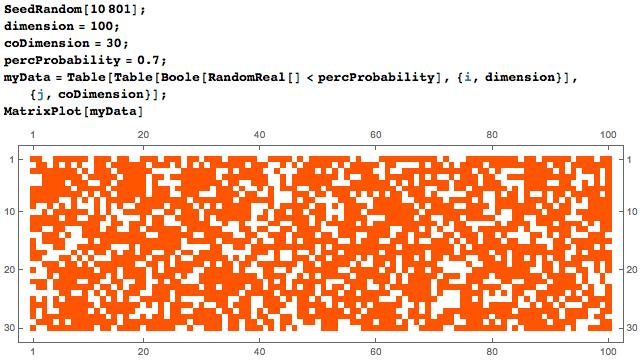Here's a solution using MorphologicalGraph[]:
SeedRandom[10801];
dimension = 100;
coDimension = 30;
percProbability = 0.7;
myData = Table[Table[Boole[RandomReal[] < percProbability], {i, dimension}],
{j, coDimension}];
img = Binarize@Image@myData;
Now all you need to do is use FindShortestPath[]. For example, the shortest path from top-left to bottom-right corner:
g = MorphologicalGraph[img]
HighlightGraph[g, PathGraph[FindShortestPath[g, 1, Max@VertexList[g]]]]

However, MorphologicalGraph[] includes corner neighbours, which we don't want in site percolation on a square lattice.
A bit of digging turned up Image`MorphologicalOperationsDump`oMorphologicalGraph[] as the function behind MorphologicalGraph. By adapting this function to ignore the thinning operation and only use corner neighbours, you can get the appropriate graph. The adapted function is at the bottom of the post.
First, let's get the left and right vertices out from your data:
getIndex[sites_, site_] := Position[sites, _?(# == site &)]
getLeftAndRightVertices[data_] :=
Module[{sites, leftsites, rightsites},
sites = Position[data, _?(# == 1 &)];
leftsites = Select[sites, #[[2]] == 1 &];
rightsites = Select[sites, #[[2]] == Last@Dimensions@data &];
{Flatten[getIndex[sites, #] & /@ leftsites],
Flatten[getIndex[sites, #] & /@ rightsites]}]
{leftvertices, rightvertices} = getLeftAndRightVertices[myData];
Now you can find the shortest path between any left vertex and any right vertex. To get the overall shortest path from left to right, you can do the following, with a warning when no path can be found.
g2 = myMorphologicalGraph[img, VertexCoordinates -> Automatic];
allpairs = Tuples[{leftvertices, rightvertices}];
allpaths = Quiet@MapThread[FindShortestPath[g2, #1, #2] &, Transpose@allpairs];
pathlengths = Length@# & /@ allpaths;
(* Workaround to deal with unconnected components which *)
(* give lengths of 0. The minimum possible path length *)
(* is of course == dimension *)
If[Max@pathlengths >= dimension,
sortlengths = Ordering[pathlengths];
pos = FirstPosition[pathlengths[[sortlengths]], _?(# >= dimension &)];
shortestpair = Flatten@allpairs[[sortlengths]][[pos]];
shortestpath = Flatten@allpaths[[sortlengths]][[pos]];
Show[img, HighlightGraph[g2, PathGraph[shortestpath]]],
(* Print warning *)
Print["No connected path found"]]
(* Left = 770, Right = 1242 *)
(* Length = 128 *)

Code for myMorphologicalGraph[]:
myMorphologicalGraph[skeleton_,
opts : OptionsPattern[MorphologicalGraph]] :=
Module[{vertices, vertexComponents, vertexCoordinates,
vertexCount = 0, linkComponents, linkCount, linkWeights,
onePixelLinks, all4all, vertex4all, vertex4vertex, vertex4link,
all8all, vertex8all, vertex8vertex, vertex8link, link8all,
link8vertex, link8link, redundantEdges, directEdges, linkedEdges,
loopEdges, cleanEdges, extraEdges, allEdges,
edgeWeights},(*vertices=ImageAdd[MorphologicalTransform[skeleton,
"SkeletonEndPoints",Padding\[Rule]0],MorphologicalTransform[
skeleton,"SkeletonBranchPoints",Padding\[Rule]100]];*)
(* Use the direct binarized image *)
vertices = skeleton;
vertexComponents =
Replace[ImageData[vertices], 1 :> ++vertexCount, {2}];
vertexCoordinates = OptionValue[VertexCoordinates];
If[vertexCoordinates === Automatic,
vertexCoordinates =
ComponentMeasurements[vertexComponents, "Centroid"]];
linkComponents =
Image`MorphologicalOperationsDump`ConstrainedMComponents[
ImageSubtract[skeleton, vertices],
Dilation[vertices, CrossMatrix[1]]];
linkCount = Max[linkComponents];
linkComponents =
Replace[linkComponents, Except[0, n_] :> n + vertexCount, {2}];
linkWeights =
Dispatch[ComponentMeasurements[linkComponents, "Count"]];
all4all =
ComponentMeasurements[vertexComponents + linkComponents,
"Neighbors", CornerNeighbors -> False];
vertex4all = Select[all4all, First[#1] <= vertexCount &];
vertex4vertex =
DeleteCases[vertex4all, _?(#1 > vertexCount &), {3}];
vertex4link = DeleteCases[vertex4all, _?(#1 <= vertexCount &), {3}];
(* Set corner neighbours to False here *)
all8all =
ComponentMeasurements[vertexComponents + linkComponents,
"Neighbors", CornerNeighbors -> False];
vertex8all = Select[all8all, First[#1] <= vertexCount &];
vertex8vertex =
DeleteCases[vertex8all, _?(#1 > vertexCount &), {3}];
vertex8link = DeleteCases[vertex8all, _?(#1 <= vertexCount &), {3}];
link8all = Select[all8all, First[#1] > vertexCount &];
link8vertex = DeleteCases[link8all, _?(#1 > vertexCount &), {3}];
link8link = DeleteCases[link8all, _?(#1 <= vertexCount &), {3}];
redundantEdges =
Image`MorphologicalOperationsDump`sortEdges[
DeleteCases[
Image`MorphologicalOperationsDump`growEdges[
Image`MorphologicalOperationsDump`growEdges[
Image`MorphologicalOperationsDump`toEdges[vertex4vertex],
vertex4link], link8vertex],
edge[_, v_, _, v_] | edge[v_, _, _, v_]][[All, {1, 3, 4}]]];
directEdges =
Select[Image`MorphologicalOperationsDump`toEdges[vertex8vertex],
OrderedQ];
linkedEdges =
Image`MorphologicalOperationsDump`growEdges[
Image`MorphologicalOperationsDump`toEdges[vertex8link],
link8vertex];
loopEdges =
Cases[Tally[linkedEdges, #1[[2]] === #2[[2]] &], {e_, 1} -> e];
loopEdges =
Pick[loopEdges,
Thread[Replace[loopEdges[[All, 2]], linkWeights, {1}] > 2]];
linkedEdges = Select[linkedEdges, First[#1] < Last[#1] &];
cleanEdges =
Join[Complement[linkedEdges, redundantEdges], loopEdges];
onePixelLinks =
Union[Flatten[vertex4link[[All, 2]]]] \[Intersection]
Cases[Tally[Flatten[linkComponents]], {_, 1}][[All, 1]];
extraEdges =
Image`MorphologicalOperationsDump`growEdges[
Image`MorphologicalOperationsDump`growEdges[link8vertex,
Select[Cases[
Image`MorphologicalOperationsDump`growEdges[
edge[onePixelLinks], link8link],
edge[_, Alternatives @@ onePixelLinks]], OrderedQ]],
link8vertex];
extraEdges =
Image`MorphologicalOperationsDump`sortEdges[
DeleteCases[extraEdges,
Alternatives @@
Cases[extraEdges,
edge[v_, l1_, l2_, v_] -> edge[_, l1, l2, _]]]];
allEdges =
Apply[UndirectedEdge,
directEdges \[Union] cleanEdges[[All, {1, -1}]] \[Union]
extraEdges[[All, {1, -1}]], {1}];
edgeWeights = OptionValue[EdgeWeight];
If[edgeWeights === Automatic,
edgeWeights =
Join[Thread[Apply[UndirectedEdge, directEdges, {1}] -> 1],
Sort[Thread[
Apply[UndirectedEdge, cleanEdges[[All, {1, -1}]], {1}] ->
1 + (cleanEdges[[All, 2]] /. linkWeights)]],
Thread[Apply[UndirectedEdge, extraEdges[[All, {1, -1}]], {1}] ->
3]]; edgeWeights =
Replace[allEdges, Dispatch[edgeWeights], {1}]];
Graph[allEdges, VertexCoordinates -> vertexCoordinates,
EdgeWeight -> edgeWeights,
Sequence @@
FilterRules[opts,
DeleteCases[
Options[MorphologicalGraph], (VertexCoordinates -> _) | \
(EdgeWeight -> _)]]]];









